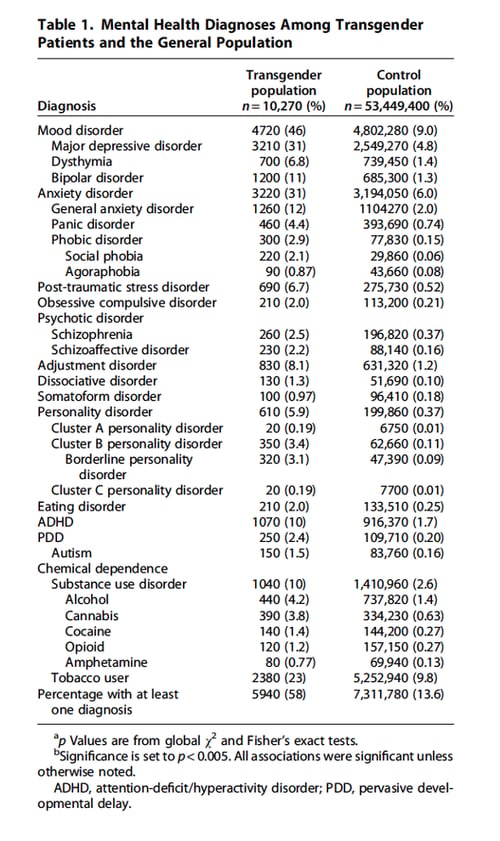Gender Incongruence
- Social incongruence refers to the social environment in which individuals are not seen and validated as the gender they identify with.
- Physical incongruence is when an individual does not feel their primary and secondary sexual characteristics are consistent with their gender.
Psychiatric Illnesses
The most prevalent psychiatric illnesses in the transgender community include mood disorders such as depression and bipolar disorder, substance use disorder, anxiety disorders, and death by suicide.

- In San Francisco, the attempted suicide rate among transgender persons is 32%, and if the individual is under 25, then that percentage increases to 50%, according to Dr. Clements-Nolle, Ph.D. and MPH, and her team in Attempted Suicide among Transgender Persons: The Influence of Gender-Based Discrimination and Victimization.
- Additionally, a clinical study by Dr. Jonathan Wanta, M.D. et al. on Transgender Health reports transgender populations are five times more likely to hold a mood disorderdiagnosis or anxiety diagnosis relative to the control population. Mood disorders are present in 46% of the transgender population in comparison to 9% in the control population, with anxiety disorders present at 31% in contrast to 6% and substance use disorder rates at 10% in comparison to 2.6%, respectively.
Dr. Brooke Ferragamo, Ph.D., practicing psychologist in the SF Bay Area, identifies PTSD, depression, and anxiety as several common diagnoses he treats in his practice with transgender clients. Comorbidity, where a combination of two or more psychological illnesses are present, is also commonly seen in transgender patients.
Dr. Ferragamo shares, “a history of trauma cascades across all identities - class, gender, immigration, etcetera. Identities aside, all human beings deserve appropriate, affordable mental health treatment.” Transgender individuals are more than their gender, and proper therapeutic treatment is effective regardless of the client’s identity.
Source: Transgend Health. 2019; 4(1): 313–315. Published online 2019 Nov 1. doi: 10.1089/trgh.2019.0029 | Jonathon W. Wanta et al. 2019; Published by Mary Ann Liebert, Inc.
Traditional Limitations
Traditional limitations when transgender individuals seek counseling include discussing gender, finances, and accessibility.
Therapy providers who aim to treat transgender populations need to utilize gender theory to understand the problems transgender individuals face. First, there is an acknowledgment that sex and gender are different terms. Sex is the biological definition of an individual’s sexual characteristics as assigned at birth. Meanwhile, gender traditionally references attitudes, feelings, and behaviors linked to an individual’s biological sex.
The idea that gender is binary is a traditional, outdated thought where individuals are only able to identify on one of two ends of a spectrum, male or female. This limited thinking excludes individuals who identify as non-binary, a conscious rejection of only male and female identities. Non-binary individuals do not identify with either gender but may identify as both, neither, or another gender entirely. Genderfluid individuals may feel their gender identity shift with time or associate on a continuous spectrum. Additionally, intersex individuals are born with both male and female sexual characteristics at birth, which contradicts the notion that gender only falls into two categories.
As individuals transition, treatment providers should create space for their client to explore their identity in a way which brings them comfort. Gender affirmation is a critical process for an individual undergoing a transition, although understanding gender oppression provides a deeper processing of the root of the problem.
Once an individual finds a fit with a therapist, then the next challenge is the financial aspect of affording the treatment. Dr. Ferragamo shares in his experience that nonbinary and transgender folk are often overeducated and underpaid. According to the National Center for Transgender Equality, statistics from a 2015 survey reveal that 29% of respondents lived in poverty, which is more than double the general population. The official poverty rate in 2015 was 13.5%, according to the U.S. Census Bureau. Poverty rates for transgender individuals of color are higher with Latinx, Black, and multi-racial transgender respondents.
Location also plays an essential role in accessibility for transgender clients. There are specific geographical locations with a larger, more accessible transgender community which makes finding a provider with the same identity or knowledge and willingness to work with transgender clients an easier task.
There are also communities that are more tolerant of diversity in gender identity; individuals in rural and conservative communities may find more success accessing treatment through telehealth and remote providers in their state. The Human Rights Campaign states the current reality is that 35.1% of transgender youth live in states that have passed bans on gender-affirming care.
To explore certification options as a remote therapy provider, explore the Foundations of Digital Mental Health, an online certification including courses such as Evidence-Based Internet Interventions to Reduce Health Disparities or Suicide, Risk Assessment, and Treatment Planning via Tele-Mental Health.
In partnership with CONCEPT, the American Board of Professional Psychology also offers a free virtual training on Demonstrating Competence in Ethics and Diversity through Board Certification led by Jeni McCutcheon, Psy.D, ABPP, Adriana Miu, Ph.D., ABPP and Kathleen T. Bechtold, Ph.D., ABPP. Board certification provides additional training and expertise, especially when working with diverse populations.
Effective Therapeutic Treatments
Dr. Ferragamo shares that he typically uses a therapeutic approach that is primarily psychodynamic and relational, which integrates elements of self-psychological, existential-humanistic, and feminist theories. He also helps clients build their coping skills when needed by including some cognitive-behavioral elements in treatment.
- Psychodynamic Therapy
- Relational Experience
- Self-Psychology
- CBT
Psychodynamic Therapy is an approach to talk therapy in which individuals self-reflect with the help of their treatment provider through the foundational lens that unconscious factors heavily influence an individual’s symptoms. In a majority of psychodynamic therapies, psychodynamic therapists create a safe environment where clients are able to speak freely. Dr. Ferragamo believes with reflection, interpretation, and guidance by the therapist, the client can often gain insight into how unconscious forces influence their thoughts, feelings, and behaviors.
Relational Experience in a therapeutic relationship refers to the importance of a strong therapeutic relationship and alliance between therapist and client as a central feature of useful therapy. Relational therapy is also effective beyond the therapeutic relationship including romantic, platonic, and professional spheres. To promote an emotionally safe space, therapists need to understand fundamental concepts surrounding gender when an individual wants to explore their gender identity or discuss their experiences of gender discrimination.
Empathy and mirroring are significant components of Self-Psychology. Psychologists who reflect and validate their client’s feelings promote the individual’s ability to reciprocate positive emotional regulation techniques outside of their treatment plan.
Cognitive Behavioral Therapy (CBT) is a standard treatment among therapeutic providers and works to help clients restructure negative frameworks that contribute to their thoughts, feelings, and behaviors. Although Dr. Ferragamo prefers the treatments mentioned above, he utilizes CBT to help clients cope with their most acute symptoms and facilitate more profound work, if necessary, early in treatment.
Resources for Transgender Clients
Certain therapeutic providers will exclusively disclose their gender identity and history, while others may not. For transgender individuals who wish to seek a transgender therapist, the following resources are available to help you connect:
- Gaylesta
- TherapyDen
- PsychologyToday
Dr. Brooke Ferragamo reiterates, “an effective therapist is willing to personalize their treatment without becoming distracted by superficial aspects of their clients’ identities and see their clients for the individuals that they are.”























